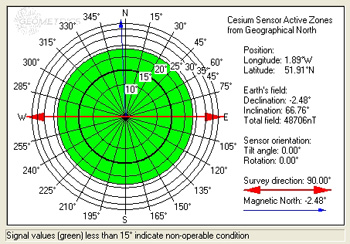Caesium Active Zones Program
All current generation optically pumped magnetometers have areas of insensitivity. Should the Earths magnetic field vector pass down this zone, called a ‘dead zone’ then the sensor will not be able to measure its strength.

In Geometrics current generation of Caesium sensors these dead zones form a cone of ½ angle 8°, about both the long axis and the equator of the sensor, thus giving an active zone of approximately 76° measured from the polar axis to the equator, through which the earths magnetic field vector must pass in order to make an accurate measurement.
When surveying with a magnetometer using optically pumped sensors, it is therefore important to ensure that you have the correct sensor orientation to ensure you do not have any data drop outs when traversing a line. As the dip angle of the Earths magnetic field vector varies depending on your geographic location, correct sensor orientation can be difficult to ascertain when performing your pre-survey planning.
To aid this task, Geometrics has produced the Caesium Active Zone program, or CSAZ for short, which is free and will install under windows. By simply inputting your latitude and longitude CSAZ will show you your optimum surveying direction, and the effects of adjusting the sensor orientation on the achievable signal to noise ratio and help you to get the best possible results from your magnetic survey.
Download Caesium Active Zones Program ( ZIP 1MB )
